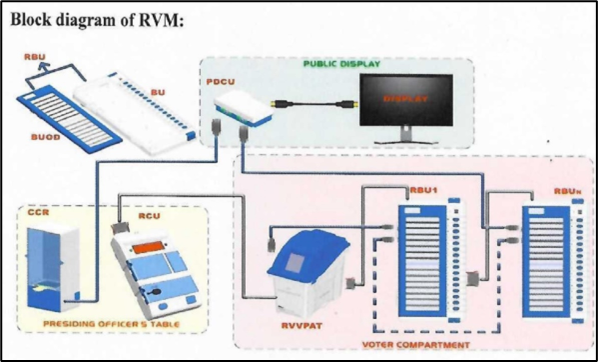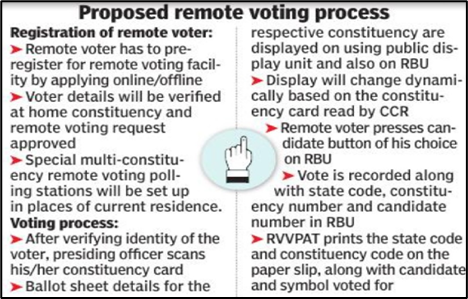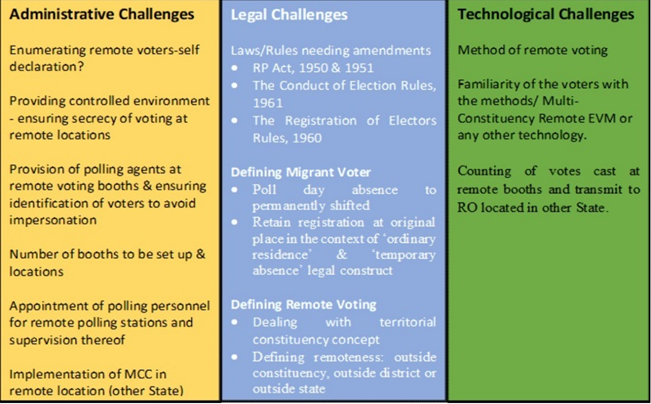Why in news?
- The Election Commission (EC) announced that it is ready to pilot remote voting for domestic migrants, so they don’t have to travel back to their home states to vote.
- For this, the commission has developed a prototype for a Multi-Constituency Remote Electronic Voting Machine (RVM).
- The ECI will demonstrate the functioning of the remote EVM on January 16 to the eight national and 57 state political parties.
What’s in today’s article:
- Remote Electronic Voting Machine (RVM) – About, working etc.
- News Summary
What is Remote Electronic Voting Machine (RVM)?
- In order to enable remote voting for domestic migrants, a technological solution was proposed in the form of Remote Electronic Voting Machine (RVM).
- RVM relies on the creation of a robust electoral roll and identification mechanisms (to stop duplicate voting), and allow voters to vote remotely, in a safe and controlled environment.
- It was developed with the assistance of Bharat Electronics Limited (BEL) and the Electronics Corporation of India Limited (ECIL). It is based on the currently used EVM system.
How does RVM work?

- The RVMs are stand alone, non-networked systems, effectively providing the voter the same experience as currently used EVMs.
- They will be set up in remote locations outside the state under similar conditions as current polling booths.
- The unique feature of RVMs is that a single Remote Ballot Unit (RBU) will be able to cater to multiple constituencies (as many as 72) by using a dynamic ballot display board instead of the usual printed paper ballot sheet on EVMs.
- The Ballot Unit Overlay Display (BUOD) will show the requisite candidates based on the constituency number read on the voter’s Constituency card.
- A barcode scanning system will be used to read these cards.
What will be the voting process under RVM?

- The voting process will be as follows: after verifying a voter’s identity, their constituency card will be read with a public display showing the constituency details and candidates.
- This will also be displayed privately, on the BUOD in the RVM’s RBU.
- The voter will then vote and each vote will be stored constituency-wise in the control unit of the voting machine.
- The VVPAT system is expected to work along the same lines with the new technology.
News Summary
Why EC is keen on remote voting for domestic migrants?
- Migration based disenfranchisement is indeed not an option in the age of technological advancement.
- The voter turnout in General Elections 2019 was 67.4 % and the Election Commission of India is concerned about the issue of over 30 Crore electors not exercising their franchise and also differential voter turnout in various States/UTs.
- One key reason for low voter turnout could be migrants not going home to exercise their franchise.
- As per Census 2011, 45.36 crore Indians, or 37% of the population are migrants, but 75% of them are migrants on account of marriage or other family-related reasons.
- The poll panel proposes to address this by using technology so that migrants can vote remotely and also stay connected with their roots.
What will be the benefits of RVM?
- Many times, migrants are reluctant to get themselves enrolled at their place of work for various reasons such as:
- frequently changing residences,
- not enough social and emotional connect with the area of migration,
- unwillingness to get their name deleted in electoral roll of their home/native constituencies as they have permanent residence/property etc.
- The remote voting initiative, if implemented, can lead to a social transformation for the migrants and connect with their roots. It will also result in better voter turnouts.
What are the different challenges that would be faced by RVM?

- There is no accurate number of migrants. Also, in 2017, the ECI had told the SC that it was not feasible to track movement of domestic migrants to allow remote voting.
- Also, migrants are not a uniform and defined class, with fluid identities, locations and situations.












